MyDigitalSSD SMART & BP3 mSATA SSD Review
by Kristian Vättö on January 22, 2013 1:24 PM ESTRandom Read/Write Speed
The four corners of SSD performance are as follows: random read, random write, sequential read and sequential write speed. Random accesses are generally small in size, while sequential accesses tend to be larger and thus we have the four Iometer tests we use in all of our reviews.
Our first test writes 4KB in a completely random pattern over an 8GB space of the drive to simulate the sort of random access that you'd see on an OS drive (even this is more stressful than a normal desktop user would see). I perform three concurrent IOs and run the test for 3 minutes. The results reported are in average MB/s over the entire time. We use both standard pseudo randomly generated data for each write as well as fully random data to show you both the maximum and minimum performance offered by SandForce based drives in these tests. The average performance of SF drives will likely be somewhere in between the two values for each drive you see in the graphs. For an understanding of why this matters, read our original SandForce article.
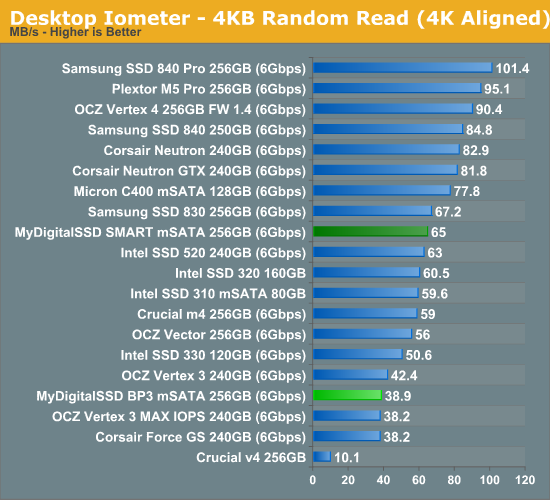
Compared to the PS3105 based Crucial v4, the BP3 offers a significant improvement in random read performance. It's still nowhere close to the fastest SATA 6Gbps drives, but at least the performance is no longer horrible. As for the SMART, its random read performance is similar to other SF-2281 based SSDs, as expected.
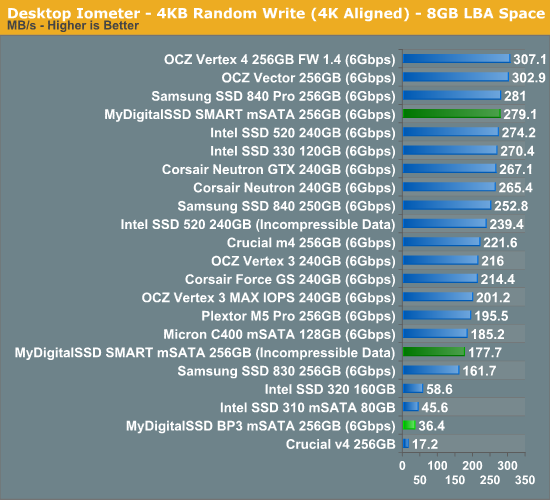
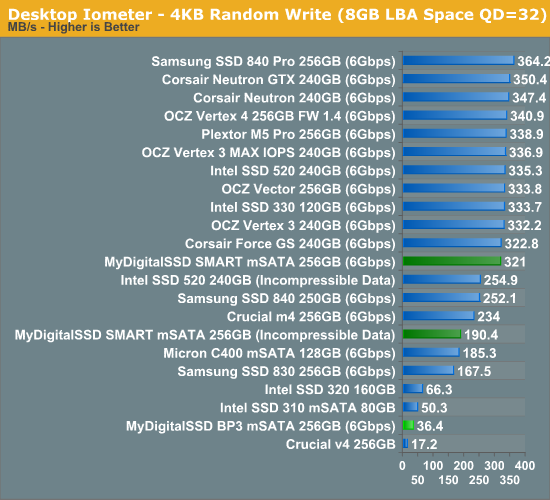
Random write speed is still the Achilles' Heel of Phison, though. The PS3108 is able to offer twice the performance of PS3105, but 36.4MB/s is still far slower than what most controllers are able to offer today. What's interesting is the fact that random write performance does not scale up at all when queue depth is increased—usually the throughput increases as the queue depth goes up as you can see in the graphs above.
Sequential Read/Write Speed
To measure sequential performance I ran a 1 minute long 128KB sequential test over the entire span of the drive at a queue depth of 1. The results reported are in average MB/s over the entire test length.
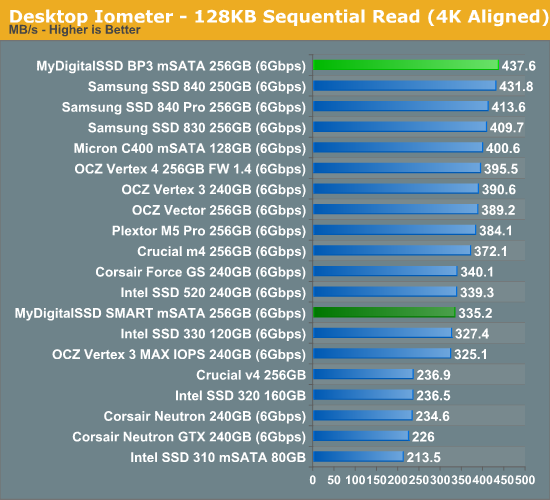
Similar to the Crucial v4, the BP3 has strong sequential performance. SMART's performance characteristics are once again typical SandForce, no surprises here.
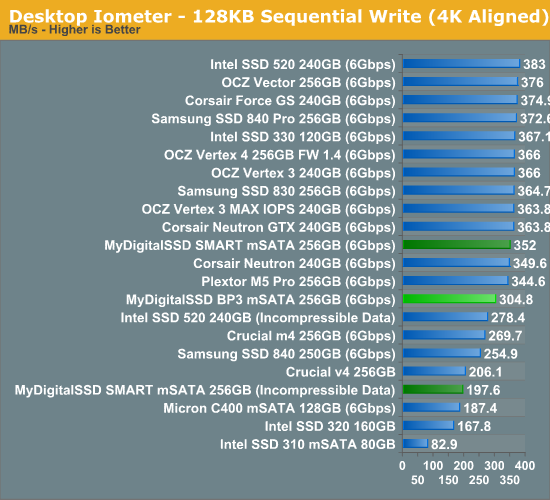
AS-SSD Incompressible Sequential Performance
The AS-SSD sequential benchmark uses incompressible data for all of its transfers. The result is a pretty big reduction in sequential write speed on SandForce based controllers, while other drives continue to work at roughly the same speed as with compressible data.
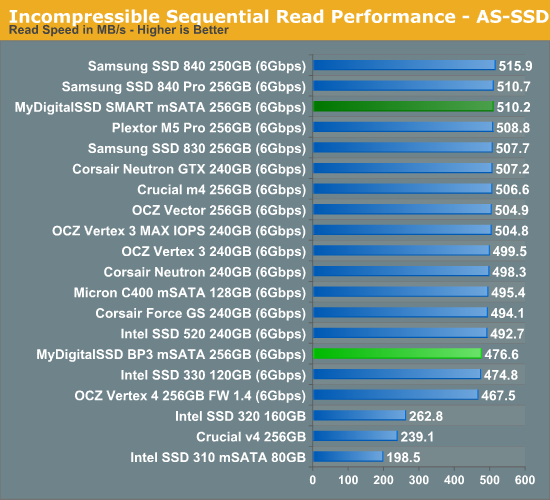
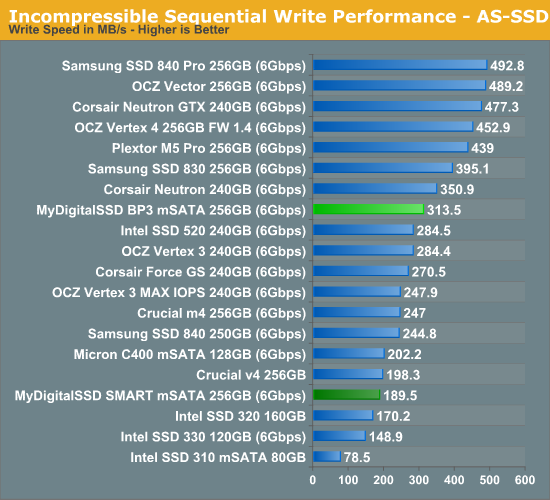










49 Comments
View All Comments
Chupk - Wednesday, January 23, 2013 - link
I love to read your reviews. And just want to give U thumbs up here knowing U R dealing with important exams at the same time while U R publishing high quality reviews.It's interesting to know U R stuck with word processing & HTML editing! >.<
I have long passed my days in University & I'm working as a Consultant in a Hospital. Just want to say the exams U R facing R kinda important. They should be your 1st priority at least for the moment!
Stranman - Wednesday, January 23, 2013 - link
It would be nice to see a comparison or charts of mSata only drives (apples to apples), not apples and oranges. If I'm looking for a mSata drive, I don't care to see standard 2.5" SSD drives listed.Kristian Vättö - Wednesday, January 23, 2013 - link
I thought about that at first but the problem is that we have only reviewed two mSATA SSDs on top of these MyDigitalSSD ones. I do have a couple more in the lab now, so stay tuned for more mSATA stuff. I think it's also worthwhile to compare them to similar SATA 2.5" drives because there is a performance difference and some might go with the 2.5" because of that.Sp4rrowhawk - Wednesday, January 23, 2013 - link
I'm a big thinkpad fan. And while my T410 doesn't have an mSata bay, both the T420 and T430 do.Also I own a home server and have a dedicated system drive. My (new) motherboard has 8 Sata ports or 7 plus 1 mSata port. As such I can't add one more drive but I can save up a 3.5" bay that would otherwise be used by my system drive. So I'm planning on buying one for that use-case. Obviously I don't need 256GB for my system drive though...
ChristopherD - Wednesday, January 23, 2013 - link
Being a traveling photographer, speed and portability is always crucial.mSATA SSD form factor coupled with an external thunderbolt chassis would be a great combo that I would purchase myself. When I have only 30mins to edit and backup a 100GB folder of photos/videos and leave a site an external SSD this small would be great.
Sottilde - Friday, January 25, 2013 - link
It seems that the M4's performance is (surprisingly) just a bit worse than the BP3's, and the M4 mSATA is just a bit more expensive. However, I'm doubtful of the longevity of Toggle-mode MLC; the last review I read on it said that it was guaranteed for only 1000 cycles. In addition this brand has a bit of a dubious name.Given those facts, which mSATA drive would you all choose?
JeBarr - Friday, January 25, 2013 - link
A full size ATX desktop board or even some mATX board users could make use of mSATA PCI-E x1, x4 or x8 with 1, 2, 3 or 4 drives in "raid". These add-on cards already exist but the price is out of reach for most outside of enterprise.I'd much rather swap out a dead mSATA drive rather than purchase another Revo drive that slowly dies.
SSDuser101 - Tuesday, February 12, 2013 - link
MyDigitalSSD has been around a while now. Since 2007 when they introduced the 1st upgrades for netbooks like the Asus 901 Mini PCI-e SSD.They have been selling mSATA SSD longer than anyone with nothing but great reviews.
Also regarding Sottidle’s post about Toshiba toggle nand. He must be thinking of TLC Triple Layer Cell Flash like what ships on the Samsung 840 drives because those do have around a 1K Cycle life span. On the contrary Toshiba Toggle NAND is the best on the market when it comes to MLC flash with a 5K R/W/E cycle minimum.
systemBuilder - Saturday, June 27, 2015 - link
Since 99% of all macbooks are shipped with a disk drive that is too small, because of Apple's horrific pricing policies, well yes, there is a huge market for mSATA drives, but only for macbooks from 2014 and earlier. The new 2015 macbooks have new PCIe drives that run 3x faster, but are not compatible with mSATA.